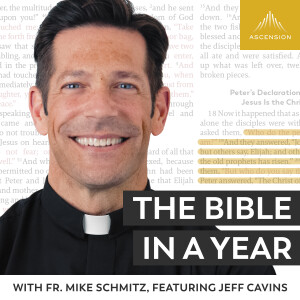

Join Tim and John as they talk about life and study John Chapter 18 Verses 1-40
Theme: https://uppbeat.io/t/northwestern/a-new-beginning
Transition Song: https://uppbeat.io/t/all-good-folks/
Introduction to John 18:1–40“The Hour Has Come”
John 18 marks the beginning of the Passion narrative—the moment where everything Jesus has foretold begins to unfold with swift and somber intensity.
The prayer is over.
The teaching is done.
Now, the betrayal begins.
This chapter opens with Jesus and His disciples crossing the Kidron Valley, entering a familiar garden where Jesus willingly steps into the hands of those who will arrest Him. This is not a story of tragedy spiraling out of control—it is the sovereign fulfillment of God’s redemptive plan.
What unfolds here is not chaos, but divine choreography.
Major Movements in John 18Section
Summary
vv. 1–11
Jesus Is Arrested – Judas leads soldiers to the garden; Jesus identifies Himself and surrenders willingly. Peter lashes out but is rebuked.
vv. 12–27
Jesus on Trial Before the Jewish Leaders – He is brought before Annas and questioned. Peter denies Him three times outside.
vv. 28–40
Jesus Before Pilate – A Roman trial begins. Pilate questions Jesus, struggles with the crowd, and famously asks, “What is truth?” before offering to release Jesus—but the crowd chooses Barabbas.
Themes to Watch For
- Jesus’ Sovereignty in Suffering: He is not caught—He steps forward. He controls the moment even as He’s betrayed.
- The Contrast of Faithfulness and Failure: Jesus remains faithful; Peter falters. Yet both stories are intertwined with grace.
- Political and Religious Tension: The religious leaders want Jesus dead, but need Roman permission. Pilate is caught between truth and pressure.
- The Reversal of Justice: The innocent is condemned; the guilty (Barabbas) is released—a powerful picture of substitutionary atonement.
John 18 forces us to confront Jesus not just as a teacher or miracle-worker, but as the Lamb led to slaughter. He stands silent before accusers, resolute before earthly powers, and unwavering in His mission.
In His betrayal, trial, and humiliation, we begin to see the depth of His obedience, the cost of our redemption, and the contrast between worldly power and divine truth.
This is not the end of the story—but it is the beginning of the darkest hours before the greatest light.
Key Theme One: The Betrayal and Arrest (John 18:1–11)“Whom do you seek?” – The Savior steps forward.
After the tender prayer of John 17, Jesus now walks into the darkness—not by accident, but by choice. The garden becomes the place of confrontation. But instead of hiding, Jesus steps forward into betrayal, showing us both His courage and His control.
1. A Garden of Surrender (v. 1–2)“Jesus went out with His disciples across the Kidron Valley, where there was a garden…”
- The Kidron Valley: This location evokes biblical resonance—this is the valley associated with sorrow and judgment (2 Samuel 15:23; Jeremiah 31).
- A deliberate setting: John doesn’t name the garden (though it is Gethsemane), emphasizing not the place, but the purpose. Jesus goes there knowing Judas will find Him.
- The familiarity of the garden: Judas knew this place. It was where Jesus often prayed—a place of fellowship, now turned into a scene of betrayal.
Reflection: Sometimes the greatest trials come in the most familiar places. But Jesus meets them head-on.
2. The Forces of Darkness Approach (vv. 3–4)“So Judas came… with lanterns, torches, and weapons.”
- Judas leads a detachment (likely Roman soldiers and temple police). The force is large, armed, and ready for resistance.
- But Jesus already knew all that was coming. He goes out to meet them—He is not hiding or afraid.
Key Insight: Jesus is not a victim here. He confronts evil with authority, initiating the interaction:
“Whom do you seek?”
3. The Divine Self-Identification (vv. 5–6)“I am He.”
- In Greek, Jesus says “Ego Eimi” — “I AM.”
This echoes the divine name God revealed to Moses (Exodus 3:14). - At these words, the soldiers draw back and fall to the ground.
This is not a metaphor. It’s a physical reaction to divine power. Even in arrest, Jesus displays sovereignty.
Application: The One who will be bound cannot be overpowered. Jesus lays down His life—no one takes it from Him (John 10:18).
4. Protecting His Own (vv. 7–9)“If you are looking for Me, then let these men go.”
- Jesus ensures His disciples are not arrested. He offers Himself in their place.
This is a picture of substitution: the Shepherd protects His sheep (John 10:11). - John notes this fulfills Jesus’ earlier promise:
“I have not lost one of those You gave Me.” (John 17:12)
Pastoral Insight: Jesus shields His followers—even in the hour of His own suffering.
5. Peter’s Misguided Zeal (vv. 10–11)“Then Simon Peter… drew his sword and struck the high priest’s servant…”
- Peter’s courage is real—but misplaced. He’s trying to protect Jesus with a sword, when Jesus is laying down His life willingly.
- Jesus’ rebuke is gentle but firm:
“Put your sword away. Shall I not drink the cup the Father has given Me?”
Theological Symbolism: “The cup” refers to the cup of suffering and wrath (cf. Isaiah 51:17; Matthew 26:39). Jesus accepts this willingly—for our salvation.
Summary of InsightsVerse Range
Event
Key Insight
vv. 1–2
Entering the garden
Jesus moves willingly into the place of betrayal.
vv. 3–4
Judas and the armed crowd
Jesus steps forward to confront evil.
vv. 5–6
“I AM” declaration
Divine authority causes even enemies to fall.
vv. 7–9
Protection of the disciples
Jesus offers Himself in their place.
vv. 10–11
Peter’s sword
Zeal without understanding cannot fulfill God’s plan.
Application Questions
- Do I trust Jesus' control even when situations look chaotic?
- Am I trying to fight spiritual battles with fleshly weapons, like Peter did?
- How do I respond when Jesus invites me to follow Him into surrender, not just victory?
- Do I recognize that Jesus willingly stepped forward—to take my place?
Faith under pressure, truth on trial.
As Jesus is arrested and led away, we are presented with two parallel stories: Jesus being questioned by religious authorities, and Peter being questioned by bystanders. One remains faithful under pressure. The other falters. Together, these scenes offer a powerful contrast between courage and fear, truth and denial, light and darkness.
1. Jesus Is Bound and Led to Annas (vv. 12–14)“They bound Him and brought Him first to Annas…”
- Annas was the former high priest and father-in-law of Caiaphas, the current high priest. Though no longer in office, he held significant influence.
- Caiaphas’s earlier statement (v. 14) frames the scene:
“It is better for one man to die for the people.”
He meant it politically; God meant it redemptively.
Reflection: Even the corrupt schemes of men can be used to fulfill the sovereign will of God.
2. Peter’s First Denial (vv. 15–18)“You aren’t one of this man’s disciples too, are you?”
- Peter follows at a distance—physically close, spiritually wavering.
- A servant girl asks a simple question, and Peter denies Jesus for the first time.
This is striking: the same man who drew a sword now crumbles under casual suspicion. - The detail about the charcoal fire (v. 18) adds an ominous tone. It foreshadows where his denials will unfold.
Key Insight: Sometimes it's not the battlefield that tests us most—but the courtyard, the everyday moment when no one’s watching but God.
3. Jesus Is Questioned by Annas (vv. 19–24)“I have spoken openly to the world… ask those who heard Me.”
- Annas tries to trap Jesus with questions about His disciples and teachings.
- Jesus responds with honesty and boldness—He appeals to His public ministry, essentially saying:
“Nothing I taught was secret. Bring forth witnesses.” - A nearby official strikes Jesus for “talking back”—Jesus again responds with truth and restraint, asking for justice, not retaliation.
Theological Note: This moment fulfills the prophecy of Isaiah 53:7—“He was oppressed… yet He opened not His mouth.”
Though here Jesus does speak, He does so with dignity and righteousness, not resistance.
“Didn’t I see you with Him in the garden?”
- While Jesus is standing for truth inside, Peter is outside denying Him two more times.
- The final question comes from a relative of Malchus—the man Peter attacked in the garden! The accusation carries weight.
- Peter denies again…
“And at that moment a rooster began to crow.”
A simple sound becomes a spiritual thunderclap. Jesus’ prophecy is fulfilled (John 13:38).
Emotional Reflection: Peter’s failure reminds us that even the boldest disciple can falter without the strength of the Spirit. But it also sets the stage for Jesus’ restoration of Peter in John 21.
Parallel Portraits: Jesus and PeterAspect
Jesus
Peter
Questioned by
Religious leaders
Bystanders
Response
Truthful, calm, dignified
Fearful, dishonest, reactive
Setting
On trial
By the fire
Outcome
Maintains integrity
Fulfills a painful prophecy
Summary of Key Lessons
- Jesus endures unjust questioning with clarity, grace, and courage.
- Peter, though once bold, is overcome by fear—but this failure will not be final.
- The scene reminds us that true discipleship is costly, and that God’s mercy is greater than our weakness.
- When my faith is questioned—do I stand firm or fall silent?
- Do I follow Jesus from a distance like Peter, or draw near with courage?
- How do I respond when I fail? Do I hide—or return to grace?
- Am I more worried about public approval than personal obedience?
The True King on Trial Before an Earthly Judge
As Jesus is brought before Pilate, the Roman governor, the Gospel of John shows a striking irony: the Judge of all the earth is being judged by a man. This scene reveals political tension, religious hypocrisy, and cosmic truth. Jesus is calm and in control—Pilate is anxious and confused. The deeper question rises: What is truth? And what will we do with it?
1. Religious Hypocrisy Exposed (v. 28)“They did not enter the governor’s headquarters, so that they would not be defiled...”
- The Jewish leaders bring Jesus to a Gentile governor, yet refuse to enter the building to avoid ceremonial defilement before Passover.
- This is bitter irony—they are meticulous about external purity while plotting an unjust execution of the innocent Son of God.
Reflection: It’s possible to be “religiously clean” on the outside while harboring corruption on the inside.
2. Pilate’s First Interrogation (vv. 29–32)“What accusation do you bring against this man?”
- Pilate quickly sees that the charges are vague and politically motivated.
- The religious leaders admit they want Jesus executed, but only Rome has the authority for capital punishment (v. 31).
- John notes this fulfills Jesus’ own prediction that He would be “lifted up”—crucifixion, not stoning (see John 12:32–33).
Prophetic Fulfillment: Even the method of execution is divinely ordained. God is sovereign over every detail.
3. The Kingdom Not of This World (vv. 33–36)“Are You the King of the Jews?”
- Pilate questions Jesus privately. Jesus responds with a profound truth:
“My kingdom is not of this world.” - Jesus affirms that He is indeed a king—but not a political or military one. His rule is based on truth, not force.
- Pilate is baffled. He can’t understand a kingdom built on spiritual authority, not swords and soldiers.
Key Theology: Jesus reigns now—and forever—not through conquest, but through the cross.
4. Truth vs. Cynicism (v. 37–38)“Everyone who is of the truth listens to my voice.”
- Jesus explains His purpose:
“For this reason I was born... to bear witness to the truth.” - Pilate famously responds:
“What is truth?”
A tragic question—truth incarnate is standing right in front of him, and he walks away.
Application: Many ask questions they don’t want answers to. Pilate’s tragedy is not ignorance—it’s indifference.
5. The Great Reversal (vv. 39–40)“Do you want me to release the King of the Jews?”
- Pilate, trying to avoid a decision, offers a Passover custom: release a prisoner.
- The crowd chooses Barabbas, a known insurrectionist, instead of Jesus.
- Barabbas, whose name means “son of the father,” is a symbol of all sinners—guilty, yet set free as the innocent One is condemned.
Gospel Picture: Jesus takes the place of the guilty. Barabbas goes free because Jesus is bound.
This is substitutionary atonement in action.
Contrast
Jesus
Pilate
Religious Leaders
Authority
Calm, Sovereign
Conflicted, Reactive
Manipulative, Hypocritical
Focus
Truth and obedience
Politics and image
Power and control
Outcome
Condemned for truth
Tries to avoid blame
Demands crucifixion
Application Questions
- Do I recognize when I’m clinging to religion but missing the heart of God?
- What kind of king do I expect Jesus to be? Am I submitting to His kingdom?
- Am I seeking the truth—or, like Pilate, avoiding it when it costs too much?
- Have I accepted that Jesus took my place, like He did for Barabbas?
The Innocent King Steps Forward
John 18 marks the beginning of the darkest hours in the Gospel—but also the clearest revelations of Jesus’ identity and purpose. In these verses, we do not see a helpless victim, but a willing Savior. Every step—from the garden to the governor’s hall—is taken with purpose, obedience, and unwavering love.
Key Reflections- Jesus Is Not Taken—He Offers Himself
From the moment He steps forward in the garden (v. 4), Jesus shows complete command of the situation. The soldiers fall at His words. He protects His disciples. He drinks the cup the Father has given Him. His arrest is not defeat—it is the doorway to redemption. - Peter’s Denial and Our Own
Peter’s failure reminds us that even passionate faith can falter when not rooted in the strength of the Spirit. Yet Jesus does not abandon Peter. This sets the stage for later restoration (John 21). There is hope after failure. - Religious Hypocrisy and Political Fear
The Jewish leaders seek ritual cleanliness while plotting murder. Pilate knows Jesus is innocent but caves to pressure. This chapter exposes how fear, pride, and power can blind us to truth—even when it stands in front of us. - Truth on Trial
Pilate’s question—“What is truth?”—still echoes today. Jesus had already given the answer in John 14:6:
“I am the Way, the Truth, and the Life.”
Truth isn’t a concept—it’s a person. And the world rejected Him. - Barabbas and the Great Exchange
The guilty goes free, and the innocent is condemned. This is more than a political exchange—this is the gospel in miniature. We are Barabbas. Jesus takes our place.
- Will I follow Jesus only when it’s safe and comfortable—or will I stand with Him when it costs something?
- Am I willing to lay down control and trust the King whose kingdom is not of this world?
- Do I allow God’s truth to shape my response to pressure—or do I, like Pilate, let fear decide for me?
- Have I embraced the exchange—letting Christ take my guilt, so I can walk in His freedom?
John 18 is a chapter of contrasts: Light and darkness. Truth and lies. Courage and cowardice.
But above all, it’s a chapter of purposeful love.
Jesus is not just walking toward a cross—He’s walking toward our salvation.
The trial has begun. But the verdict that matters most has already been settled:
The Lamb of God is willing.
The King has stepped forward.
The Redeemer is ready.
More Episodes
All Episodes>>You may also like
Create Your Podcast In Minutes
- Full-featured podcast site
- Unlimited storage and bandwidth
- Comprehensive podcast stats
- Distribute to Apple Podcasts, Spotify, and more
- Make money with your podcast












